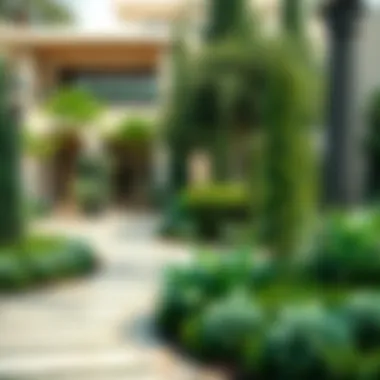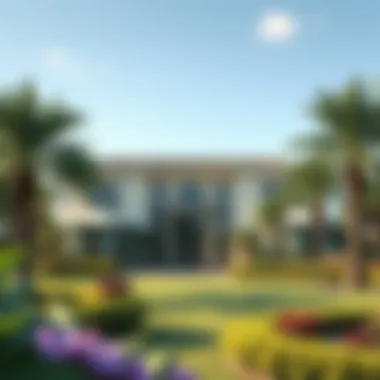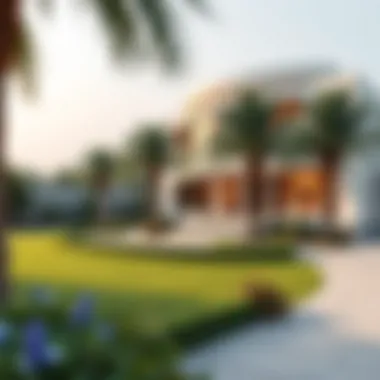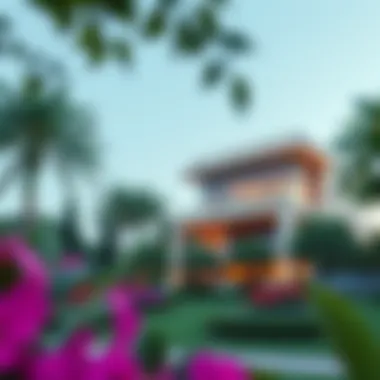Exploring Park Greens in Dubai's Luxury Real Estate


Intro
In the heart of a region known for its architectural marvels and grandeur, a subtle yet powerful force is reshaping the landscape of luxury real estate in Dubai. This force is none other than park greens. Often overlooked in conversations dominated by iconic skyscrapers and opulent villas, these verdant spaces are pivotal in creating a balanced living environment. Not just patches of green, they are integral to the allure of high-end properties, elevating the value of investments and the quality of life for residents.
Park greens bring a fresh touch to Dubai's extravagant real estate scene. They serve more than aesthetic purposes; they enhance community cohesion, provide a breath of fresh air amidst the urban hustle, and act as a magnet for potential homeowners and investors who value outdoor spaces. As high-net-worth individuals seek properties that cater to both luxury and a healthy lifestyle, the demand for homes near or adjacent to green spaces has seen a notable uptick.
This conversation about park greens is not just academic; it has tangible consequences in property listings, market trends, and community development. Understanding these nuances can be a game changer for investors, developers, and buyers alike. Through this exploration, we aim to peel back the layers and reveal how these parks influence vital decisions in the luxury real estate market, making them much more than just an afterthought in the grand design of Dubai's living spaces.
Why Park Greens Matter
Park greens contribute significantly to the ecological and social fabric of urban life. They are the lungs of the city, improving air quality and providing refuge for local wildlife. Beyond environmental benefits, they foster community interactions, promoting a sense of belonging among residents. Homebuyers are increasingly looking for properties that incorporate these features as they recognize the direct correlation between green spaces and enhanced quality of life.
Now, let’s take a deeper look into key aspects surrounding property listings, market insights, and more. Each segment will further illustrate the vital role that park greens play in refining Dubai's luxury real estate landscape.
Intro
In the bustling city of Dubai, where opulence meets ambition, park greens play a pivotal role in shaping the luxury real estate landscape. These green spaces are far more than ornamental; they serve as vital elements that influence the quality of life for residents while simultaneously boosting property values. The allure of the Emirate is not just in its skyscrapers or lavish malls, but also in the tranquil parks and vibrant gardens that dot its expanse.
The importance of incorporating park greens into urban environments cannot be overstated.
- Enhancing Property Values: Proximity to well-maintained green spaces can markedly increase property values. Prospective buyers often consider parks as essential amenities. For instance, families are drawn to areas that provide not only a roof over their heads but also outdoor spaces for recreation and relaxation.
- Promoting Aesthetic Appeal: Parks enhance the visual landscape, providing a striking contrast to the concrete jungle. They offer aesthetic value that is sought after in high-end real estate, making developments more appealing at first glance. A beautiful garden or park can often be the deciding factor for potential buyers during a property viewing.
- Impact on Community Well-Being: Beyond financial aspects, park greens contribute significantly to mental and physical well-being. Access to green spaces promotes healthier lifestyles, providing opportunities for outdoor activities such as jogging, cycling, and family picnics, ultimately leading to more vibrant communities.
These elements intertwine to showcase how integral park greens are to the luxury market in Dubai. Investors and stakeholders must appreciate that their value reaches beyond mere property listings; they encapsulate lifestyle aspirations and community wellness. As we delve deeper into the various facets of park greens throughout this article, we will explore their definitions, historical context, and the profound impact they have on luxury living in Dubai.
"In essence, park greens are the living fabric of urban landscapes, weaving together the aspirations and well-being of its inhabitants."
This article, therefore, serves as a compass for real estate agents, investors, expatriates, property developers, and homebuyers alike, providing crucial insights into the role and significance of green spaces in Dubai's thriving luxury real estate market.
Understanding Park Greens
In the grand tapestry of urban development, park greens emerge as vital threads that enhance both the beauty and functionality of a city. Their presence in Dubai’s luxury real estate landscape is nothing short of transformational, influencing the lifestyle choices of its residents. Understanding park greens isn’t just about their physical attributes; it encompasses various benefits they offer, which range from improving property values to fostering a sense of community. In this section, we will drill down into the essence of park greens, revealing their inherent value.
Definition of Park Greens
Park greens refer to designated areas within urban settings that are specifically reserved for greenery, recreational activities, and environmental conservation. These spaces typically serve a dual purpose: they provide aesthetic beauty while acting as a crucial buffer against the sprawling concrete of city life. In Dubai, where modern architecture thrives, these greens play a significant role in softening the urban environment, creating a balance between man-made structures and natural elements.
Types of Park Greens
When discussing park greens, it’s essential to differentiate among the various types. Each category contributes uniquely to enhancing Dubai's luxury real estate experience.
Public Parks
Public parks are open to all and often feature amenities like playgrounds, walking paths, and picnic areas. They serve as communal hubs where individuals from all walks of life converge, promoting social interactions and community cohesion. One significant advantage here is accessibility; everyone can enjoy a public park, making it a popular choice among families and fitness enthusiasts alike. However, the challenge lies in maintaining such large spaces, requiring consistent investment in upkeep to ensure they remain welcoming and safe.
Private Gardens
Private gardens, as the name suggests, are exclusive spaces attached to individual properties. These greens offer a retreat into nature, often featuring thoughtfully designed landscaping, water features, and even outdoor entertainment areas. One key characteristic of private gardens is the level of customization available to homeowners, allowing them to create a personal sanctuary that reflects their tastes and lifestyle. While they serve as a haven, they come at a premium price, making them a more exclusive and potentially less accessible option compared to public parks.
Community Green Spaces
Community green spaces act as a middle ground between public parks and private gardens. These areas are typically maintained by local residents and involve various community efforts. They encourage engagement and participation, often hosting events or workshops that foster a sense of belonging. Their unique feature lies in their capacity to adapt, frequently changing based on community needs. On one hand, they provide a feeling of ownership and pride among residents; on the other hand, inconsistent maintenance or lack of organization could hinder their appeal.
"Park greens are not merely patches of grass; they are the lungs of the city, breathing life into urban chaos."
In summary, understanding the various types of park greens available in Dubai helps illuminate how these spaces cater to different segments of the population while contributing significantly to the overall luxury real estate landscape. Whether it’s the openness of public parks, the exclusivity of private gardens, or the communal spirit of community green spaces, each type serves a unique role in enhancing the city’s living environment.
Historical Context of Urban Greenspaces
Understanding the historical context of urban greenspaces is crucial to appreciate their role in shaping modern cities, particularly in luxury environments like Dubai. Urban greenspaces have evolved significantly over the decades, with their importance transcending mere aesthetics to encompass social, cultural, and ecological functions. Recognizing how these spaces emerged can shed light on current trends in urban planning and real estate development.
Evolution of Greenspaces in Urban Planning
The evolution of greenspaces reflects changing societal values and needs. Initially, greenspaces were primarily practical, serving as necessary agricultural land. As cities expanded, maintaining these areas for recreation gained traction. In the 19th century, the industrial revolution grew the urban population, leading to crowded living conditions. In response, planners and architects began to recognize the need for parks as havens of beauty and leisure.
Key Stages in the Evolution of Greenspaces:
- Late 18th to Early 19th Century: Emergence of public parks as a response to industrialization.
- Mid-19th Century: Influences from England, particularly the design principles espoused by figures like Joseph Paxton, led to the creation of landscaped parks.
- 20th Century: Greenspaces began to be integrated into urban planning at a macro level, focusing on community health and sustainable living.
In cities like Dubai, the strategy has often been about blending the old with the new—retaining cultural identities while enhancing urban living through innovative greenspace designs that add to property values.


Case Studies from Major Cities
Examining successful examples from other major cities provides a template for understanding how park greens can influence Dubai's luxury real estate landscape. Let's take a look at three iconic examples:
New York's Central Park
Central Park is perhaps the most famed urban greenspace in the world, a vast oasis amid the chaos of Manhattan. Its contribution to city life can't be overstated. Key Characteristics:
- Size and Design: Encompassing over 840 acres, designed by Frederick Law Olmsted and Calvert Vaux, it blends natural landscapes with refined architecture.
- Cultural Hub: Hosts events that enrich community engagement and social interaction, enhancing the overall value of surrounding properties.
The unique feature of Central Park is its vastness, offering residents a multitude of recreational opportunities. However, one disadvantage is the management of crowds, which sometimes detracts from the peaceful experience.
London's Hyde Park
Hyde Park is another landmark that illustrates the value of greenspaces. Located near the heart of London, it serves a diverse population, from residents to international tourists. Key Characteristics:
- Accessibility: Seamless connections to major transportation routes ensure a steady flow of visitors.
- Rich History: A space for public gatherings and historical events that bolster community pride.
One unique feature of Hyde Park is the Serpentine, a picturesque lake that attracts those interested in leisure activities. The downside is that its popularity can lead to overcrowding during peak times, affecting the tranquil feel of the park.
Singapore's Gardens by the Bay
In stark contrast, Singapore's Gardens by the Bay is a modern marvel that showcases how innovation can reshape urban greenspaces. Key Characteristics:
- Sustainability Focus: Features advanced horticultural practices, including the Supertree Grove, which are both aesthetically pleasing and environmentally friendly.
- Architectural Ingenuity: Combining science and art, the gardens utilize cutting-edge technology for irrigation and energy.
The unique feature here is the Cloud Forest, a cooled conservatory that offers visitors a unique ecological experience right in the heart of a bustling metropolis. However, its luxurious appeal creates challenges for affordability in nearby real estate.
Urban greenspaces are no longer just parks; they are vital components in the complex tapestry of modern urban living. The lessons learned from these case studies will undoubtedly influence the developmental strategies employed in Dubai’s luxury real estate market, reinforcing the concept that greenspaces add intrinsic value to both the environment and properties.
Park Greens and Luxury Living in Dubai
In the heart of Dubai, where the skyline reaches for the stars, park greens stand as a testament to the city's vision of luxurious living. These lush ecosystems don’t merely adorn the landscape; they play a pivotal role in shaping the lifestyle that many expatriates and affluent buyers seek. The deliberate inclusion of green spaces into luxurious developments embodies more than aesthetics; it intertwines beauty, mental tranquility, and community health.
Impact on Property Values
Financial Assessments
A careful look at financial assessments reveals an interesting relationship between park greens and real estate values in Dubai. Properties nestled alongside these green spaces tend to have escalated prices. Potential buyers often perceive homes near parks as more desirable, leading to inflated property values. The characteristic feature of this assessment lies in its ability to quantify the premium that green spaces bestow upon real estate. In essence, financial assessments become a crucial tool for investors, providing insights into investing wisely. However, while the benefits are clear, one must also tread carefully, as excessive reliance on these assessments can sometimes overlook other valuable aspects of property.
Market Comparisons
When discussing market comparisons, the significance of green spaces is stark. Properties around parks frequently gather more interest compared to those that are isolated. This feature amplifies their allure, allowing for a vivid representation of the market landscape. Buyers looking for high-end properties understand the advantages of such proximity, often standing in stark contrast when juxtaposed with comparable homes. This comparative nature reveals the economic implications of investing in luxury real estate adjacent to parks, however, while this understanding can guide investments, it can also lead to inflated expectations if market conditions shift.
Enhanced Aesthetics
Visual Appeal
Visual appeal is not merely a pleasant aspect; it is a driving force behind Dubai’s property market. Parks inject life into the urban structure, offering a refreshing break from the bustling environment. They create an inherently attractive backdrop, making properties more appealing to buyers. This visual aspect serves the dual purpose of enhancing the overall neighborhood aesthetic while boosting property desirability. However, while visually enticing, the maintenance of such aesthetics involves continuous investment and effort from property owners.
Architectural Integration
Architectural integration pertains to how seamlessly these greenspace blend with the structures they surround. In Dubai, architects skillfully incorporate park greens within residential developments, ensuring that the two elements enhance each other. Effective designs create an ambience that fosters relaxation and community interaction. However, there's a unique challenge; finding the perfect balance between maintaining luxury standards and respecting the ecological framework is often complex. An overemphasis on opulence could lead to the neglect of green space sustainability, ultimately defeating the purpose of such integration.
Community Health and Well-being
Physical Benefits
The physical benefits of park greens cannot be downplayed, particularly in a city where residents cherish active lifestyles. Access to open green areas promotes outdoor activities, encouraging residents to embrace various forms of exercise. For families and health-conscious individuals alike, this aspect transforms parks into essential hubs for physical well-being. Yet, it is crucial to recognize that simply having access doesn't guarantee utilization; community programs must exist to encourage engagement.
Mental Benefits
Meanwhile, the mental benefits offer a compelling narrative. Green spaces can reduce stress and enhance the overall quality of life. They provide a serene escape from the city's frenetic energy, allowing individuals to unwind. The calming presence of nature is scientifically proven to improve mood and cognitive function. However, like physical benefits, the effectiveness relies heavily on maintaining a well-designed, accessible park that invites community interaction. Ignoring these mental health aspects could undermine the purpose of developing such spaces.
"Green spaces in urban areas are not just luxury; they are crucial to sustaining a healthy and happy community."
Overall, the intricate relationship between park greens and luxury living in Dubai forms a dynamic landscape, captivating potential buyers and investors alike. By recognizing these nuanced benefits, stakeholders in Dubai’s real estate market can make informed decisions that enhance community life, aesthetic appeal, and overall well-being.
Ecological Significance of Park Greens


Within the extravagant backdrop of Dubai’s luxury real estate, park greens play a pivotal role that transcends mere aesthetics. They contribute significantly to the ecological balance, creating a sanctuary for wildlife while enriching the urban fabric. This section examines the intricate layers of ecology that park greens embody, exploring how they not only enhance the environmental quality but also align with global sustainability goals. The importance of integrating these natural spaces in urban settings can’t be overstated. Park greens nurture biodiversity, bolster community health, and serve as natural buffers against climate challenges.
Biodiversity in Urban Areas
The concept of biodiversity involves the variety of life found in a particular habitat. In urban environments, such as Dubai, preserving biodiversity is crucial for maintaining healthy ecosystems. Park greens, with their diverse plant and animal populations, act as important ecological corridors connecting isolated habitats. These areas attract various species, facilitating the interaction of flora and fauna that would otherwise struggle to survive in the rapidly urbanizing landscape.
- Habitats for Wildlife: Park greens provide essential habitats for local wildlife, including pollinators like bees and butterflies, which are necessary for the pollination of many plants.
- Soil Health: Diverse plant life contributes to healthier soils, reducing erosion and enhancing carbon sequestration—the process by which trees and plants absorb carbon dioxide from the atmosphere.
- Natural Pest Control: A diverse ecosystem helps maintain natural pest control, reducing the need for chemical pesticides that can harm both the environment and human health.
These factors illustrate that park greens are not just pleasant to look at; they’re vital for sustaining urban biodiversity.
Sustainability Practices
Sustainability practices in park greens help mitigate the environmental impact of urban development, ensuring that green spaces are maintained for future generations. Two key practices stand out in this context: water management and native plant utilization.
Water Management
An effective Water Management system is vital in desert cities like Dubai, where water scarcity is a pressing concern. The strategy involves designing landscapes and irrigation systems that significantly reduce water consumption.
- Key Characteristic: Smart irrigation systems, including drip irrigation, ensure that every drop counts by directing water precisely to where it's needed.
- Benefits: This not only conserves water but also promotes the growth of healthy plants, making park greens more resilient to extreme heat.
- Unique Feature: Rainwater harvesting systems are employed to capture rainfall, which can be reused for watering plants, significantly enhancing the sustainability of park areas.
By adopting efficient water management strategies, park greens in Dubai can thrive despite the arid climate.
Native Plant Utilization
The use of native plants in landscaping is a vital aspect of sustainability that brings numerous benefits. Native plants are those that naturally occur in a specific region; they require less water and maintenance than exotic species.
- Key Characteristic: Native plants have adapted to the local climate and soil conditions, making them inherently more resilient and easier to sustain.
- Benefits: Their installation reduces the reliance on fertilizers and pesticides, leading to fewer pollutants entering the local ecosystem.
- Unique Feature: They provide habitat and food for local wildlife, thus fostering a vibrant ecosystem within urban settings.
Integrating native plant species in park greens not only enhances biodiversity but also promotes a sustainable and environmentally friendly landscape.
Integration of Park Greens in Urban Architecture
The blending of park greens within the architectural fabric of urban Dubai holds not only aesthetic value but also a profound impact on functionality, community engagement, and resident well-being. As luxury real estate continues to flourish in this vibrant city, the incorporation of lush green spaces becomes a keystone in both architectural design and urban planning, signifying a shift towards more sustainable living environments.
Green Roofs and Vertical Gardens
Green roofs and vertical gardens have emerged as innovative solutions to urban landscaping challenges. These features utilize often neglected spaces atop buildings or along walls, transforming them into flourishing ecosystems. For instance, in skyscrapers like the Burj Khalifa, where horizontal land space is scarce, green roofs help mitigate heat, improve air quality, and foster biodiversity—all while offering breathtaking views for residents.
Additionally, these architectural enhancements support insulation, which can significantly reduce energy costs. By embracing greenery at different heights, Dubai is redefining luxury, placing value on not just the living space, but the entire environment surrounding it.
Design Considerations
Functionality vs. Aesthetics
The balance between functionality and aesthetics is a defining characteristic in the integration of park greens into urban architectural projects. Functionality ensures that spaces serve distinct purposes—whether it's for relaxation, recreation, or social interaction—while aesthetics contributes to the overall beauty and appeal of the structure. A striking example can be found in Emaar's The Address Boulevard, where the lush landscaping not only beautifies the property but also creates functional zones for residents to indulge in outdoors. Thus, well-designed spaces elevate a property’s desirability and perceived value without compromising on livability.
Space Optimization
In a city known for its innovative skyline, space optimization emerges as a critical strategy for maximizing the utility of both residential and communal areas. Parks, gardens, and recreational zones integrated into new developments can utilize vertical space effectively, accommodating several functions within compact areas. For example, community parks often combine playgrounds, jogging paths, and leisure spaces without requiring extensive ground coverage.
The unique challenge lies in designing these environments to serve diverse community needs while remaining visually appealing and accessible. While densely populated areas pose challenges, ideas like multi-story parks or green walls present viable solutions, ensuring that urban green spaces remain accessible without wasting precious land.
Epilogue
In sum, the integration of park greens in urban architecture in Dubai represents a forward-thinking approach to modern luxury living. By weaving together layout functionality with aesthetic appeal and space optimization, developers can cultivate environments that enhance real estate values while promoting a healthier community. This urban strategy embodies the evolution of luxury, channeled through mindful design and sustainable practices that are expected to shape the future of Dubai's urban landscape.
Community Engagement with Park Greens
Community engagement with park greens plays a pivotal role in shaping the luxury real estate landscape in Dubai. It's not just about having these spaces; it’s the active involvement of residents that enhances their value, meaning, and utility. Engaging communities in park activities fosters a sense of ownership and pride, impacting property appeal and investment attractiveness.
The essence of effective community engagement lies in its inclusivity, ensuring that different demographics—from families to retirees—find activities and spaces that resonate with their needs. In luxury real estate, where lifestyle is a significant selling point, vibrant community interactions can drive demand and even justify premium property prices.
Events and Activities
Festivals
Festivals held in park greens serve as a cornerstone for community bonding and cultural exchange. They transform these green spaces into hubs of social activity, encouraging local participation and drawing visitors. One key characteristic of these festivals is their versatility; they can feature food markets, art displays, and live performances, appealing to a broad audience. The vibrancy of such events attracts both residents and potential buyers, showcasing the beauty of community engagement.
A unique feature of park festivals is their ability to create memorable experiences. When residents come together to celebrate, it reinforces community ties and enhances the overall perception of the area. This can lead to an increase in property values, as people are more inclined to invest in neighborhoods rich with culture and social life. However, an ongoing challenge is managing the logistics of these events—traffic, noise, and cleanliness must be handled meticulously to ensure they remain enjoyable.


Fitness Programs
Fitness programs in park greens emphasize health and wellness while creating a connected community environment. These programs typically include yoga sessions, jogging clubs, and fitness boot camps, appealing to health-conscious residents. The attribute that stands out the most about such programs is their ability to foster a robust social network among participants, thus amplifying the community aspect.
A unique benefit of fitness programs is their accessibility. Unlike indoor gyms, park settings allow individuals of various fitness levels to participate and enjoy outdoor activities, making it easier for everyone, from beginners to fitness enthusiasts. However, these programs can be limited by weather changes, which might deter participation on rainy or extremely hot days.
Educational Programs
Environmental Education
Environmental education initiatives within park greens cultivate a deeper appreciation and understanding of nature among community members. Programs often involve workshops or guided walks where residents can learn about local flora and fauna, promoting a sustainable mindset. A notable characteristic of such programs is their focus on fostering active citizenship, as attendees become advocates for preserving green spaces.
The real advantage to such educational efforts is their long-lasting impact. Participants carry forth this knowledge into their daily lives, which can lead to community activism aimed at protecting local environments. Yet, one disadvantage could be the retention of information; without follow-up opportunities, knowledge gained might swiftly evaporate.
Gardening Workshops
Gardening workshops engage community members by teaching them practical skills while also beautifying the local landscape. These workshops are not merely about planting but rather about cultivating community spirit through shared tasks. One characteristic that makes gardening workshops appealing is their hands-on approach, providing participants with tangible results—lush greenery or blooming flowers.
Such workshops also have a unique feature: they promote sustainability by teaching residents about local plant species, composting, and organic gardening. However, a drawback may arise if interests are not aligned; not all community members may be inclined toward gardening, limiting participation. Engaging participants could require additional strategies to attract a wider audience.
In summary, community engagement with park greens is essential for enhancing the luxury real estate landscape in Dubai. Activities such as festivals, fitness programs, and educational workshops create a lively and attractive environment for residents and visitors alike. Each initiative brings its challenges and unique advantages, shaping how communities interact with their park spaces. As these green areas evolve, so too will the opportunities for enhancing community living and property values.
Future Trends in Park Greens Development
As Dubai continues to carve a niche in the luxury real estate domain, the role of park greens is evolving rapidly. These green havens are not merely aesthetic add-ons; they are integral components that influence property values, promote well-being, and foster community engagement. With advancements in technology and a shift towards sustainability, the future of park greens in Dubai is bound to be influenced by innovative landscaping techniques and smart technologies in urban greens. Understanding these trends is vital for investors and property developers who aim to stay ahead of the curve.
Innovative Landscaping Techniques
Dubai's landscape is a canvas waiting for creative strokes. Innovative landscaping techniques are set to revolutionize park greens, merging beauty with functionality. For instance, using xeriscaping—a landscaping method that reduces or eliminates the need for irrigation—can enhance green spaces without straining local water resources. Additionally, the focus on natural biodiversity is also rising. Incorporating native plants that flourish in local climates not just conserves water but provides habitats for urban wildlife.
Some particular methods gaining traction include:
- Vertical gardens: These allow greenery to flourish in urban settings where land is scarce.
- Eco-friendly materials: Using sustainable materials such as bamboo or reclaimed wood contributes to a lower carbon footprint in landscaping.
- Rain gardens: These installations are designed to manage stormwater runoff while adding beauty to the surroundings.
By embracing these innovative techniques, park greens can transform from traditional parks to multifunctional spaces serving ecological, recreational, and aesthetic purposes.
Smart Technologies in Urban Greens
Integrating smart technologies in the development of park greens can potentially transform how these spaces are managed and experienced. The rise of the smart city concept has influenced several urban planners to consider technology in landscaping. From automated irrigation systems to real-time environmental monitoring, these technologies help maintain the vibrancy and health of green spaces.
Consider the following advancements:
- IoT sensors: Sensors can monitor soil moisture and weather conditions, ensuring plants receive the right amount of water and care based on real-time data.
- Smart lighting: LED fixtures that adjust based on natural light levels not only save energy but also enhance the aesthetic appeal of the park at night.
- Mobile applications: Apps can provide community members with information about events, plant species, and park features, fostering greater engagement and awareness.
These technologies not only optimize the utility of park greens but also attract a more tech-savvy demographic and add intrinsic value to luxury properties surrounding these spaces.
"Investing in smart technologies for park greens ensures not only their longevity but also enhances user experience, making them a cornerstone of luxurious living in Dubai."
As we look toward the future, the melding of innovative landscaping and smart technologies in park greens is poised to impact Dubai's luxury real estate landscape profoundly. Real estate agents, investors, and homebuyers need to recognize and embrace these trends to capitalize on opportunities that arise as the city continues to flourish in its green endeavors.
Additional resources to explore include Wikipedia on Urban green spaces and the Science Direct article on Smart Cities.
Epilogue
In closing, the significance of park greens in Dubai's luxury real estate landscape cannot be overstated. These vibrant green spaces serve as a cornerstone for high-end living, culminating in benefits that resonate deeply with both residents and investors.
The Value Proposition
First and foremost, park greens escalate property values. Buyers often look for a home that includes serenity and accessibility to nature, which green spaces undeniably offer. Not just a visual delight, these areas represent an investment in quality living, making properties adjacent to lush parks particularly coveted.
Health and Well-being
Moreover, the role of park greens extends far beyond aesthetics. They contribute significantly to community health and well-being. Easy access to parks promotes physical activities such as jogging, walking, and recreational sports, which fosters not only health but also a sense of community. Regular engagement in these activities can lead to lower stress levels and improved mental health among residents.
Environmental Considerations
Additionally, environmental sustainability is a pressing concern that park greens help to address. Their presence contributes to biodiversity within urban settings and helps mitigate urban heat. By soaking up rainwater and filtering pollutants, these green spaces support ecological balance which is crucial in a city like Dubai.
Future Outlook
Looking ahead, the integration of smart technologies into park designs may further amplify their benefits, making them even more interactive and efficient. This could enhance the user experience and overall community involvement, ensuring that these spaces remain vibrant and relevant.
"The evolution of urban greenspaces reflects a city's commitment to quality of life, asserting that luxury doesn't just lie in opulence but also in the quality of one's surroundings."
In summary, as we navigate the evolving landscape of luxury real estate in Dubai, park greens stand out as pivotal entities. Through enhancing property values, promoting health, and supporting environmental sustainability, these spaces are not merely adjuncts to luxury living; they are essential components that enrich urban life and drive investment decisions. Understanding this can offer real estate agents, investors, and homebuyers a strategic edge in a competitive market.



